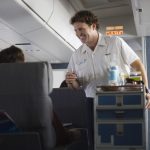There were 480 people in hospital with the coronavirus disease, 119 of whom were in intensive care. The new coronavirus figures come as the state grapples with a labour shortage.Premier Dominic Perrottet told journalists on Saturday there was a dire shortage of hospitality and agricultural workers to handle a surge in trade after the state’s lockdown.“We know, particularly with reductions in immigration, reductions in skilled labour, international students not returning at this stage, it‘s made it incredibly difficult for many industries to get the workers that they need,” Mr Perrottet said.“The feedback I‘ve received over the last week is trade’s up 200 per cent and staff down 50 per cent. That is a real challenge facing the hospitality sector in New South Wales. And we’ll continue the discussions with the federal government.”Covid-19 restrictions further eased for fully vaccinated people across NSW this week after the state passed its 80 per cent double vaccination target. Mr Perrottet said the state had been in discussion with Federal government again over restrictions on working hours.“We’ll look towards potentially making some changes there again,” he said.“But the first focus for us, is to get people back into work, to get businesses open. So it is a good challenge to have. It’s a better challenge than having high unemployment and not having demand in businesses right across the state.“Hang in there, we are opening up.”Meanwhile, Australia’s medical regulator will consider an application from Pfizer to use extra shots of the vaccine to boost protection against Covid-19.Deputy chief health medical officer professor Michael Kidd said a Therapeutic Goods Administration committee would meet on Monday to look at the new data submitted by Pfizer.“Pfizer has submitted the data which the TGA needs to look at, and that will be happening on Monday, whether there is further information required from Pfizer, we’ve got to wait and see what the TGA determines,” he said on Saturday. He expected the rollout of the booster shots to be ready as early as November 8, with priority given to aged care, disability care and frontline health workers.People who have had two Covid-19 vaccine shots will likely get their third, booster jab six months after the last one. “I don’t want to pre-empt what the committee is going to decide, but once we have formal approval – if that’s provided by the TGA – we also have to get the formal recommendations from ATAGI (Australian Technical Advisory Group on Immunisation),” professor Kidd said.The TGA was yet to receive information from AstraZeneca regarding booster shots.“As further vaccines are approved for use in Australia, we may well see the so called mix and match occur with people who may receive two doses of one vaccine and a booster dose of another vaccine,” he said.“It remains to be seen as to what is recommended as providing the best protection and the best support over time. “Obviously the TGA and ATAGI are following the research, which is underway around the world with a number of these vaccines, but also the real life experience which is happening in other countries as well, and all that will help to inform future recommendations.”Professor Kidd said the purpose of boosters was mainly to slow down the spread of the virus. “There is little evidence at this time that protection against severe disease wanes over time in those who are double vaccinated,” he said.“But what we do know is that antibody levels fall over time and there is a risk of breakthrough infections where vaccinated people may become infected and at risk of transmitting COVID-19 to others.”Third doses of Covid-19 vaccines were already being offered to severely immunocompromised Australians.But authorities said those doses were not necessarily defined as boosters — as they were aimed at lifting the level of protection in those people, up to the same level as others who only required two doses.About 86.4 per cent of Australians aged 16 and over had received one Covid-19 vaccine dose and 72.5 per cent are fully vaccinated.NSW was leading the country with more than 80 per cent of the state’s population fully inoculated.Victoria also had strong numbers, with more than 70 per cent fully vaccinated.Queensland, South Australia, the Northern Territory and Western Australia were all yet to reach 80 per cent on first doses, and 70 per cent on second doses.NAT – Stay Informed – Social Media
Powered by WPeMatico


